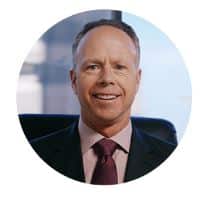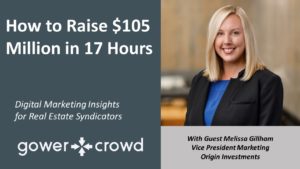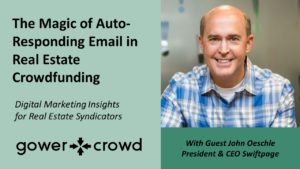231 Harold Hofer, Co-Founder and CEO, Rich Uncles

Harold Hofer, Co-Founder & Rich Uncle
Harold Hofer is Canadian born and, consequently like me, a subject of the Queen. He moved to the California when he was a kid and grew up in the Los Angeles area eventually attending UCLA where he received both undergraduate and master's degrees in economics, followed by a law degree, also at UCLA. Harold practiced law for a couple of years when I got out of school and his college roommate was working for a real estate firm in Orange County where he now lives. He accepted his roommate’s suggestion that they go into business together and putting together little syndications to buy the projects that his firm was building and selling.
In the 1980s they were raising money using Reg D private placement partnerships to buy real estate and raised around $80 million in equity for some $300 million worth of real estate. In the mid-1990s they sold their company to Koll in Newport Beach, California that was, at the time, run by Ray Wirta, Harold’s current partner. Ray took Koll and merged it with the predecessor to CBRE in 1997, ascending to the CEO role. Several years later they took the company private and then took it public again, consequently having quite a successful ride.
Reinvention
When Ray retired as active CEO of CBRE in around 2005 he had a checklist of things he wanted to do that he hadn’t been able to do in real estate because of the structural confines of CBRE. Incidentally, at time of writing, Ray remains chairman of the board of CBRE.
One of the things they had wanted to do was to find a way to use the Internet to aggregate investor capital to buy real estate. They thought real estate in general as an industry was slow to embrace modern technologies and as many industries and companies were effectively using the Internet to create efficiencies and cost savings so the wondered why real estate wasn’t falling lockstep as quickly as it should have been. One of their ideas was to raise capital with an online format versus having to raise capital through brokers as was commonplace.
That was the idea they had in 2005, 2006 and they went ahead in 2007 putting together a public offering in Texas in a REIT format to raise capital from small investors to buy interest in a shopping center that they had purchased, raising about $3 million. Shortly thereafter the economy went off the edge of the cliff and so they mothballed this concept of raising capital online at that time. But then the JOBS Act came about in 2012. One of the premises of the JOBS Act was to make the aggregation of capital easier for small businesses. Harold was re-intrigued with the idea of raising capital in an online format to buy real estate, aggregating small investors with an online platform to buy real estate.
Leaders of The Crowd
Conversations with Crowdfunding Visionaries and How Real Estate Stole the Show
Discover how laws that gave us crowdfunding were solely meant to finance small companies and yet inadvertently opened the doors to allow you to invest in real estate like never before.
Read the book and listen to the actual conversations.
Invest Here!
Now, in 2005 2006 when had raised money using general solicitation in Texas they had been able to do so because it was a REIT and because it was an instate public offering i.e. they were not under the under the purview of the SEC. They had used an investment in state offering exemption from SEC registration requirements. As they had been able to get their offering approved by the Texas regulators, this had allowed them to use general solicitation to raise money to buy real estate from non-millionaire, unaccredited investors.
They did all sorts of advertising in Texas trying to get people interested. They put little flyers on the door knobs of people who lived in the area of the shopping center they had purchased. They put a sign out on the street that said, ‘Own a piece of the shopping center, go to the Web site!’
Despite these efforts though, they didn't really gain traction though they believe now that they were simply ahead of their time in terms of the market receptivity to that sort of an idea. Plus, of course and not trivial, the economy went off the edge of the cliff stemming the enthusiasm with which investors viewed their proposition. They had, in short, the right idea but bad timing.
It had become well known that the JOBS Act was coming out and that it had many permutations. The primary initial thing that was intriguing to Harold and Ray was that it allowed for general solicitation under Reg D private placement offerings. Before the JOBS Act if you wanted to put together a Reg D offering you could only present it to people that you knew or believed to be accredited. You couldn't really just stand on a street corner with a sign saying ‘Invest Here!’
How to Fund Your Deals
7 Steps to Raising Equity Online
The JOBS Act
The JOBS Act allowed you to have general solicitation for a Reg D offering. They had never done a Reg D offering what intrigued them was the idea of going back out and raising capital from the public using an online platform as it was being reawakened by the JOBS Act. They decided to get back on the bandwagon.
Their premise has always been that they wanted to make offerings open to non-millionaire, non-accredited investors. The JOBS Act introduced the Reg A+ element where it expanded the size of the Reg A offerings to $50 million which was intriguing because it also allowed for general solicitation of both accredited and non-accredited investors alike. That said, they decided not to avail themselves at least initially of Reg A+, but instead to do another instate public offering, this time in California. They did a non-SEC offering for non-accredited, non-millionaire investors that allowed for general solicitation within California and they launched that around 2013. Again, they used the REIT structure they were familiar with from their work in Texas six years or so earlier, working with the exemption from SEC filing responsibilities by operating entirely within one state known as the ‘intrastate offering exemption’, Rule 147.
Under this Rule, as long as they were confining the offering to California residents they were OK. They could tell where by identifying IP addresses when people try to access their platform where they're coming from. This allowed them to preclude access to the platform if someone was trying to come from a state where the offering was not approved at that time. Consequently, if you were in any state other than California you'd be denied access to the platform if the software detected that you were trying to access our platform from outside of California.
Large Investor Base
Using this public offering in California, they decided to move ahead with a $25 million equity offering that they ended up upsizing twice from $25 to $50 million, and then again to $100 million because they were raising quite a bit of capital using a $2,500 minimum amount from investors who wanted to own real estate. They realized that there is considerable demand from the investors to own real estate but that most investors don't know how to access it, nor would they know how to analyze or underwrite a publicly listed REIT plus are fearful of the liquidity within the unlisted REIT market.
Non-traded REITs had been selling this product type for many years through broker dealers with a 10 percent commission associated with it, but Harold’s business model was to go direct to the consumer and present the same investment opportunity. They would not charge consumers a 10 percent commission by using the Internet to effectively be the distribution method rather than the broker dealer community to be your distribution method. Their thought was not to necessarily to disintermediate the broker dealer community but rather to expose the sort of investment opportunity to investors who qualified for the offering financially but did not have a broker dealer to begin with.
The financial suitability standards for these sorts of offerings are $75,000 in income or $250,000 of net worth, so it's a much broader base of investors than the accredited investor standard which is $200,000 of sustained income or a $1 million in net worth. A much larger investor base could be participating in these sorts of offerings and Harold could expose products to investors directly rather than through the broker dealer community which is which is how that money had traditionally been raised in the past.
Fund Doubled Twice
After the JOBS Act was passed, Harold didn't rely upon any particular element of the Act initially. It was just the idea that JOBS Act jarred his and Ray’s thinking. They realized that the market was pulling out of recession and that this Act will result in people trying to raise money online for real estate investments. They saw it giving rise to many of their peers in the real estate industry adopting crowdfunding methodologies. They wanted o expose offering opportunities to smaller non-accredited investors but immediately after the Act was passed, it really just stimulated the idea that while other people were jumping on the bandwagon to raise capital from for real estate investing from a whole disparate group of investors with an online platform, that they should too.
Their initial offering, the on that had doubled twice, closed in the middle of 2016 by which time they had raised over $85 million. It had ramped up slowly and then accelerated. They started wondering that if this was playing so well in California, could it play on a national scale, so they had a public offering registered with the SEC which became available to sell in mid-2016. They shut down the California offering at that time and opened up with the same investment strategy but this time on a national scale through a new SEC registered but not publicly traded REIT format.
It was the JOBS Act that allowed them to solicit nationally, where before they had been restricted to instate offerings. They could have used the REIT structure within a Reg A+ format but chose to do an S11 offering which is a fully registered offering through the SEC. Recognizing that the Reg A+ offering process with the SEC was much more simplified than the process they actually used, they had not wanted to be limited to raising $50 million per year and, believing that they could raise more money than that had not want to have to shut one down at $50 million and start another one thereafter.
Regulation A+ Pros & Cons
Now, some folk are using Regulation A+ to raise more then $50 million in any given year by creating entities that specialize in different asset classes or geographical regions. While Harold knows of folk doing that, initially he thought that there was a danger that the SEC would integrate those offerings and say Hey, wait a second you're just trying to evade the intent of the Reg A+ $50 million limitation by segregating it, splitting hairs geographically or splitting hairs in terms of product type. Being uncertain how that might eventually play out, Harold and his partner Ray were not 100 percent sure that will ultimately prevail, and concerned that the SEC might say these are one big offering were leery of trying to be the guinea pig trying to test that system.
The whole premise of the Rich Uncles is different than most other crowdfunding platforms. Most other crowdfunding platforms are trying to create a marketplace matching accredited investors on the one hand with real estate sponsors on the other. Harold’s business model has always been to make the product available to non-accredited investors, plus they are the end user of the capital that they raised and not just a matchmaking site. Harold and Ray are real estate people by background not tech people by background. Rather than take your money and give it to some third party real estate sponsor they thought that they could do as good a job or better than any third party sponsor in terms of investing your capital prudently.
Non-Accredited Investors
Their challenge as a company in terms of customer acquisition was really focusing on finding investors not trying to find real estate – and this did not mean trying to find competent real estate sponsors as they were principals in their own real estate ownership. Their business model differed from most of their peers in the real estate crowdfunding space in that they focused on just aggregating capital from investors and then we would ourselves handle the investment of the product, and because they focused from the get go non-accredited investors.
A couple platforms have morphed over to embrace non accredited investors as well that Harold at Rich Uncles had pioneered in making product available to.
Rich Uncles started with two products. The first was a single tenant, triple net lease product. If you could look at a spectrum of real estate in terms of risky versus less risky probably perhaps the riskiest might be, say, hotels because the income stream effectively changes daily in a hotel depending on occupancy and what you're charging per hotel room. On the other side of the spectrum is single tenant net lease product types where you've got long term leases with creditworthy tenants on a triple net basis where they pay their taxes, their insurance, and their maintenance, so Harold focused on the less risky side of the spectrum which is single tenant triple net lease.
He also kept leverage, the amount they borrow against the properties, to 50 percent. In short, they opted to buy a conservative investment product type within real estate and cap financial leverage at 50 percent. The idea was that they have a lot of investors that have very limited exposure to real estate investing and they wanted to create a story that was easily comprehensible by a neophyte real estate investor and to lower on the risk spectrum from real estate relative to other investment opportunities that there might be in real estate.
The $5.00 Minimum
The product is, therefore, focused on current yields. Harold’s thought was that if you try to explain to one of his investors what internal rate of return means they will likely have their eyes glaze over so keeping the product type based on current yield kept it simple and easy to understand. They have recently launched a second product type on the platform and are, as of time of writing, working on putting a Reg A+ product on the platform also.
What came to intrigue Harold about Reg A+ is as follows. If you look at the broader landscape of 260 million adults in the United States, with maybe 3 percent or so, 10 million are accredited investors. Included those that would qualify for their single tenant net lease offering having $75,000 in income per year or $250,000 of net worth, that might add another, say, 25 million people. This encompasses maybe the top 25 percent of the adult US population, with another 25 percent of the population meeting the financial suitability standards of the current offering we have for single tenant net lease. Reg A+ effectively opens up to everyone – as long as an investor represents that the investment they make does not exceed 10 percent of their annual income or 10 percent their net worth. Harold likes that this levels the playing fields entirely by making real estate investing open to everybody. To do this, they have launched a Reg A+ offering that is student housing faced and the minimum investment is $5 so you can get into it for five dollars.
Just $5.00 minimum.
RELATED PODCASTS
320 Melissa Gillham, Vice President Marketing, Origin Investments
Last Updated on June 22, 2020 by Dr. Adam Gower WHITE BOARD WORKSHOP Need More Money to Finance Your Real Estate Projects? Learn how to find more investors, raise more…
READ MORE >402 Soren Godbersen, Chief Growth Officer – Equity Multiple
Last Updated on September 15, 2021 by Dr. Adam Gower Soren Godbersen, Chief Growth Officer – Equity Multiple Crowdfunding insights for real estate developers NEW BOOK BY ADAM GOWER PH.D.…
READ MORE >322 John Oechsle, President & CEO Swiftpage
Last Updated on September 15, 2021 by Dr. Adam Gower WHITE BOARD WORKSHOP Need More Money to Finance Your Real Estate Projects? Learn how to find more investors, raise more…
READ MORE >













